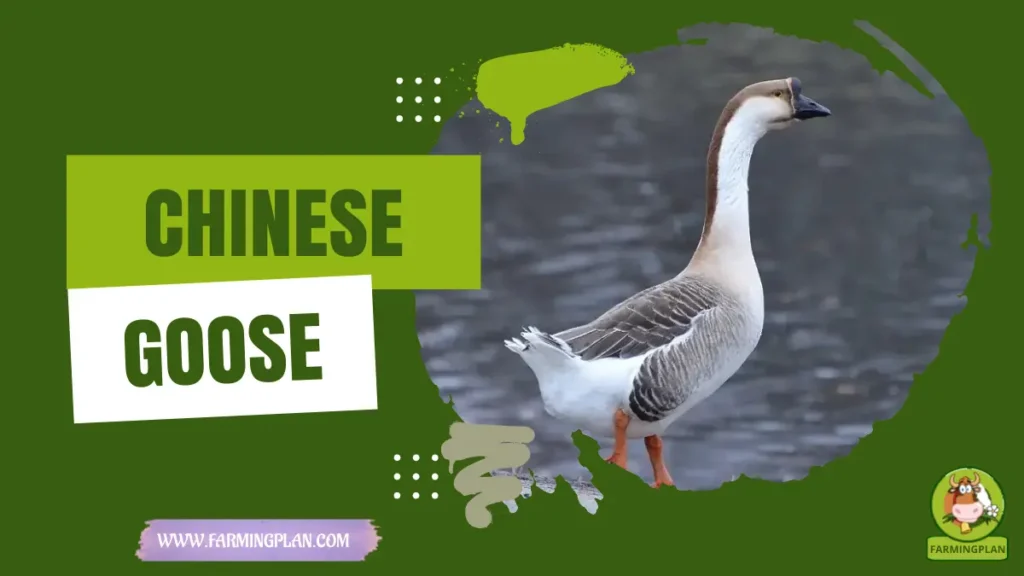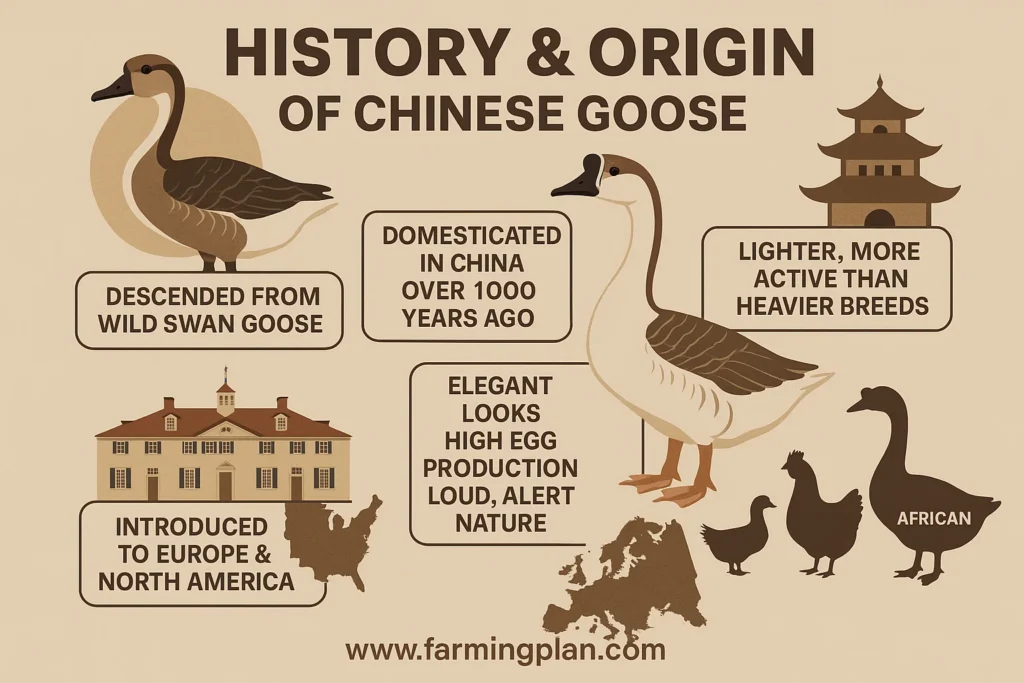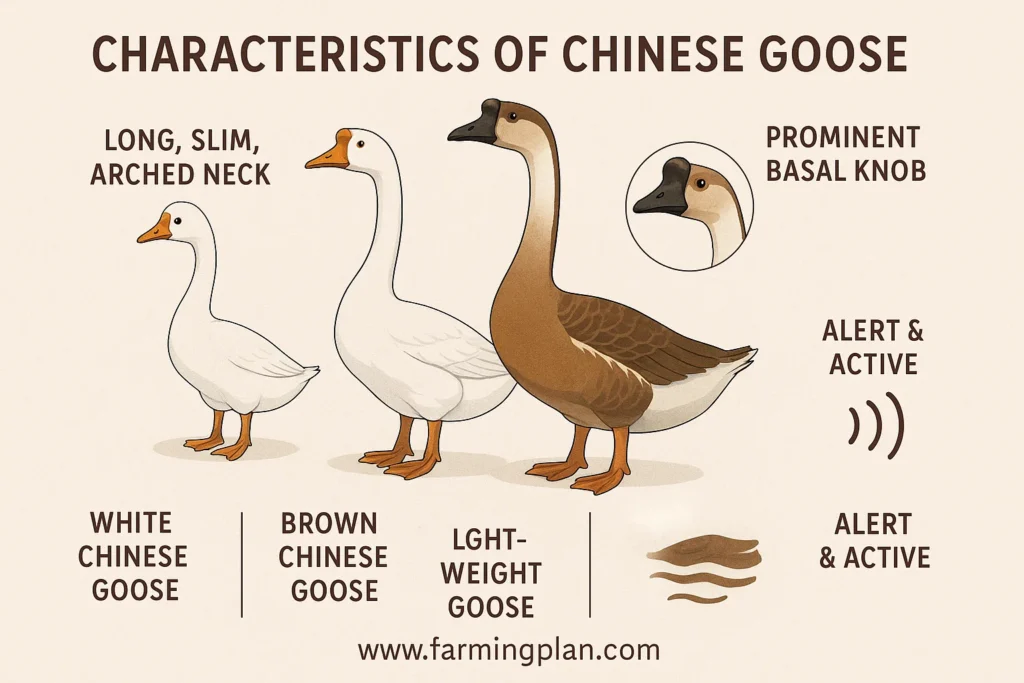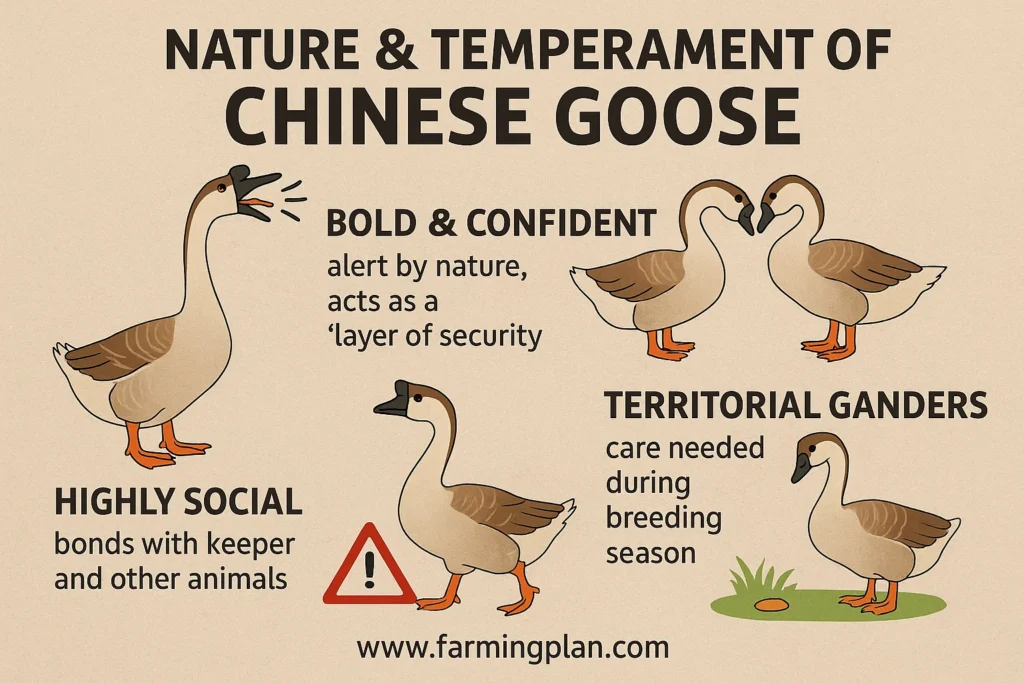The Chinese Goose is one of my favorite breeds to raise, thanks to its striking appearance, long arched neck, and lively personality. Available in white and brown varieties, these geese are not only elegant but also highly productive, known for excellent egg-laying and keeping order in the farmyard. Descended from the Asiatic Swan Goose, they add beauty and utility to any flock. In this article, I’ll share hands-on tips and insights from raising these birds myself—from caring for fluffy goslings to managing full-grown geese. Whether you’re a pet owner, hobbyist, breeder, or farmer, you’ll find practical advice and a step-by-step guide to help you succeed with this confident and useful breed.

History & Origin of Chinese Goose
Chinese Geese are actually descendants of the wild Swan Goose, also known as the Asiatic Swan. These birds were first domesticated over a thousand years ago in China and quickly became prized for their elegant looks, high egg production, and loud, alert nature—perfect for use as guard geese.

The breed was introduced to Europe and North America much later. Thomas Jefferson even kept Chinese geese at Mount Vernon. Over time, they’ve become a popular breed around the world, especially on small farms and homesteads. Unlike heavier breeds like the African goose, Chinese geese remained a lighter, more active option that fit well into a mixed flock. With their history stretching from ancient dynasties to today’s farm catalogs, these geese have proven themselves again and again.
Read More: African Goose Care Guide For Healthy And Happy Birds
Characteristics of Chinese Goose
Chinese geese are known for their long, slim, and gracefully arched necks—some of the most elegant necks among all goose breeds. They come in two distinct color varieties: the white Chinese goose and the brown Chinese goose. The white variety has stunning white plumage with a bright orange bill and legs, while the brown variety features a russet-brown neck stripe that runs down their otherwise dark, earthy-colored feathers.

Both types have a prominent basal knob at the top of their bill, which gives them a swan-like appearance. This knob can actually help you sex goslings early on—males (Chinese ganders) typically have a larger knob. Mature birds are generally light-weight geese, not classified as a heavy goose, making them a breeze to manage. And let’s not forget—their alert postures, confident walks, and piercing calls make them a truly eye-catching goose in any flock.
Read More: Kangan Goose: Secrets to Successful
Nature & Temperament of Chinese Goose
Chinese geese have a bold and confident temperament. They’re alert by nature, often acting as a “layer of security” on the farm. I’ve had my Chinese ganders honk like there’s no tomorrow at anyone unfamiliar—they’re better than a watchdog!

These birds are highly social, especially when raised from goslings. They bond with their keepers and other animals in the flock. I always remind folks that although they’re not “fighting geese,” they do guard their turf. Care with ganders during breeding season is key—they can get a little territorial. Their personalities can range from bossy to sweet, and they’re quick to respond when trained from a young age. I’d even say they’re among the most responsive goslings I’ve raised. Once bonded, they love their routine, fresh-cut grass time, and the occasional treat.
Read More: Hawaiian Goose: How To Start A Farm At Home
Food & Diet of Chinese Goose
Feeding Chinese geese doesn’t have to be fancy. I let mine graze on fresh green grass as much as possible. They’re excellent foragers and do well on a pasture-based diet. This access to grass also keeps their elegant necks in top shape—no joke!
Besides grazing, I supplement with cracked corn, oats, or a general poultry grain. During the breeding season, I make sure to offer higher-protein feeds to support egg production. Clean water is a must—geese love to dip their food in water before eating. Avoid feeding them moldy grains, salty snacks, or too much bread. A mineral grit supplement can help with digestion. If you want beautiful, healthy birds and high egg yields, stick to a clean, natural diet.
Give Them Grass, A Little Love, And A Pond To Patrol—Chinese Geese Will Reward You With Eggs And Entertainment!
Usage & Purpose
Chinese geese, when well cared for, can live for 10-15 years. This is a significant commitment, but one that can be incredibly rewarding. Chinese geese serve multiple roles. First and foremost, they’re one of the best egg-laying goose breeds. A mature female can lay up to 60–100 eggs per year—far more than most domestic goose breeds. Their large, creamy-white goose eggs are rich and nutritious.
They’re also popular as guard geese. Their loud honking deters unwanted visitors, and they won’t hesitate to rush at intruders—human or otherwise. I’ve seen them chase off dogs! Chinese geese are also common in poultry exhibitions, thanks to their refined appearance. Whether you’re entering them in the junior poultry fair or browsing poultry catalogs for an American exhibition bird, they’ve got that show-stopper look.
Special Features
The long, elegant neck with its arched posture sets Chinese geese apart. It’s not just for show—this neck helps them spot threats from a distance. The white Chinese goose variety, in particular, looks like a swan gliding across the pasture.
The basal knob isn’t just ornamental either. It’s a hallmark of the breed and plays a role in distinguishing sexes. Female goslings and male goslings can often be sorted just by their knob development, especially in the white variety. They’re known to be exceptional layers, often outperforming other goose breeds. Their sleek neck stripe and lightweight build make them incredibly graceful birds to watch.
Health Issues & Prevention
Chinese geese are healthy birds overall, but a few things can trip them up if you’re not careful. The most common issues I’ve dealt with are:
- Worms – Especially if they graze all day. A seasonal deworming schedule works well.
- Wet Feather – Happens when feathers lose waterproofing. Good pond hygiene and preening time prevent this.
- Knob Injuries – Their basal knob can get scratched or bruised. Always check for swelling or signs of infection.
Prevent problems by keeping their area dry, clean, and predator-proof. Regular health checks, clean water, and nutritious feed go a long way. Always separate sick birds to prevent spreading. A layer of prevention keeps everything running smooth on the farm.
Step-by-Step Farming Guide
Step 1: Set Up The Right Environment
Start with a safe, enclosed space. I prefer predator-proof fencing with shaded areas and access to a pond or kiddie pool. These birds love water, but they don’t need a lake to thrive. Keep the bedding dry and change it often. Add a nesting area for females when they’re ready to lay. You’ll need 3–5 geese per gander for a balanced flock.
Step 2: Choose Healthy Goslings Or Hatching Eggs
You can buy Chinese goslings or start with Chinese geese eggs for sale. I like buying from trusted hatcheries like Metzer Farms. Healthy goslings should be alert, fluffy, and active—avoid any with deformed necks or closed eyes. Hatchlings need a heat source and shallow waterers to avoid drowning. Watch them closely in their first week!
Step 3: Daily Feeding & Watering Routine
Feed goslings a non-medicated starter with 18–20% protein. Slowly reduce protein as they age. Once mature, grass and grain work fine. Water should always be fresh and available. Geese dip their food in it, so keep it clean or you’ll get soggy feed everywhere!
Step 4: Monitor Growth And Behavior
Watch their posture and walking. That arched neck should develop as they grow. If you see signs of stress or weight loss, it’s time to reassess their diet or environment. Also keep an eye on their gander behavior—some can get overprotective during breeding.
Step 5: Breeding And Egg Collection
In spring, the breeding season begins. Provide private nest boxes with straw. Collect eggs daily to prevent damage or predation. Store goose eggs properly if you’re incubating. You can hatch them in an incubator or under a broody goose if she’s willing. I’ve had better hatch rates with machines, to be honest!
Expert Tips & Best Practices
- Use knob size to sex goslings early—it’s a helpful trick!
- Rotate pasture to prevent overgrazing and parasite buildup.
- Don’t overcrowd. Chinese geese like their space—at least 10 square feet per bird.
- Offer a quiet time area for nesting females.
- During winter, switch to higher-calorie feed for warmth.
- Display them at poultry shows—they’re great for youth programs.
- Use a poultry waterer with a deep enough basin for bill dunking.
- Always observe during breeding season—ganders get feisty!
FAQ
Are Chinese geese good egg layers?
Yes! They’re one of the best egg-laying goose breeds, with 60–100 eggs annually.
Can Chinese geese be kept as pets?
Absolutely. They’re social, intelligent, and bond well with humans when raised from goslings.
What’s the difference between Chinese and African geese?
Chinese geese are lighter, have longer necks, and lay more eggs. African geese are bulkier and more mellow.
How do I tell males from females?
Males (ganders) have a larger knob and a deeper honk. Females have a smaller knob and lay eggs, of course!
Are Chinese geese noisy?
Yes, they are! But that’s what makes them great guard geese.
Conclusion
Chinese geese are more than just beautiful birds—they’re smart, social, productive, and downright fun to raise. Whether you’re drawn to their white plumage, their russet-brown neck stripe, or their egg-laying power, they bring a whole lot of value to any farm or home. With the right setup, healthy feed, and some daily care, you’ll find that these confident birds are both a joy to raise and a helpful part of your flock. Ready to add some elegance and utility to your homestead? Give Chinese geese a try—you won’t regret it! Have you raised Chinese Geese before? Drop a comment—I’d love to hear your experience!
